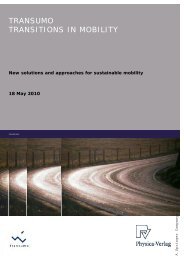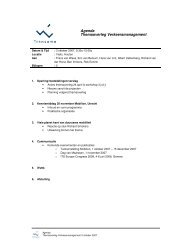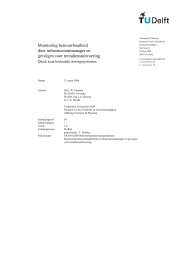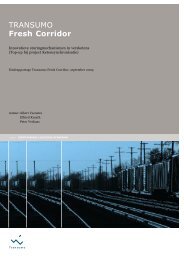Casestudie Breakdown prediction Contell PILOT - Transumo
Casestudie Breakdown prediction Contell PILOT - Transumo
Casestudie Breakdown prediction Contell PILOT - Transumo
Create successful ePaper yourself
Turn your PDF publications into a flip-book with our unique Google optimized e-Paper software.
assumed to be asymptotic and only the stationary state is used for calculations. This<br />
leads to a linear system of equations that can be solved with less effort again. 56<br />
Both, Markov chains and Markov processes have become important analyzing<br />
methods within many different settings. As mentioned above, they can be used, for<br />
instance, to predict the time of first occurrence of a critical system state. Looking<br />
back to the setting of machinery condition monitoring from section 4.2 would allow to<br />
use Markov chains, for example, to predict upcoming malfunctions due to friction.<br />
([Waldmann04], p. 6-7)<br />
The Markov property seems to be promising also within the setting of sensor based<br />
temperature monitoring because a cooling device may malfunction at any time, no<br />
matter how long it worked fine before. But as already mentioned in section 2.2.5, a<br />
real technical malfunction has a very low unknown probability. Hence, starting<br />
distribution and transition matrix cannot be determined.<br />
5.8 Inferential Statistics<br />
In contrast to descriptive statistics, inferential approaches do not describe available<br />
datasets but try to generalize gained knowledge from existing data. These methods<br />
are applied to problems where data cannot be obtained entirely. The general idea is<br />
to analyze a representative sample of the statistical universe. But only in case of a<br />
really representative sample, the gained results can be applied correctly to the whole<br />
statistical universe. ([Eckey02], p. 242)<br />
The generalization of gained information is always bound to probability calculation.<br />
Hence, the general approach of inferential statistics is to determine the distribution of<br />
a representative sample. Afterwards, this distribution can be used to perform interval<br />
estimations, hypothesis testing or other similar methods. 57<br />
An application to sensor based temperature monitoring would require such a<br />
representative sample to determine the distribution. But in fact, such a representative<br />
sample does not exist, because of the randomness of external influences. This<br />
problem could partly be solved by applying monitoring data of a longer time period as<br />
representative sample to calculate the distribution.<br />
56 See ([Waldmann04], Chapter 4) for details<br />
57 See (e.g. [Scharnbacher04]) for details<br />
72
















